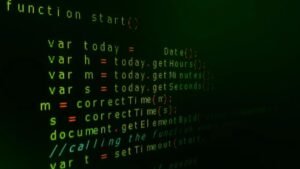Can AI Learn New Things?
Artificial Intelligence (AI) has come a long way in recent years, with advancements in machine learning and deep neural networks enabling AI systems to perform complex tasks. But the question remains: can AI learn new things? The answer is yes! AI has the ability to learn and adapt through various techniques, allowing it to acquire new knowledge and skills.
Key Takeaways:
- AI has the capacity to learn and acquire new knowledge.
- Machine learning and deep neural networks play a crucial role in AI’s ability to learn.
- AI can learn through techniques such as supervised learning, unsupervised learning, and reinforcement learning.
**Machine learning** algorithms form the basis of AI’s ability to learn new things. These algorithms allow AI systems to process and analyze vast amounts of data, identifying patterns and making predictions. By utilizing **deep neural networks**, AI can simulate the learning capabilities of the human brain, enabling it to learn from examples and improve its performance over time. AI systems can discover hidden patterns and correlations in data that may not be immediately obvious to humans.
**Supervised learning** is one of the most common techniques used by AI to learn new things. In this approach, the AI system is provided with a labeled dataset, where each data point is associated with a known output. The system then learns to make predictions by finding patterns in the labeled data. *For example, an AI system can be trained to recognize images of cats by providing it with a dataset of labeled cat images.*
In contrast, **unsupervised learning** enables AI systems to learn without labeled data. The system identifies patterns and structures in the data, making sense of the information without any specific guidance. *Through unsupervised learning, AI can cluster similar data points together and discover hidden relationships between variables.*
Tables:
| Methods | Description |
|---|---|
| Supervised Learning | Uses labeled data to train AI systems and make predictions. |
| Unsupervised Learning | Allows AI systems to learn without labeled data, identifying patterns and relationships. |
Another learning technique employed by AI is **reinforcement learning**, which involves an AI system learning through trial and error. The system takes actions in an environment and receives feedback in the form of rewards or penalties. By maximizing the cumulative reward over time, the AI system gradually learns to make better decisions. *Reinforcement learning has been used to teach AI systems to play complex games like chess or Go at a superhuman level.*
Tables:
| Advantages | Disadvantages |
|---|---|
| Ability to learn from labeled data | Requires large amounts of training data |
| Can identify hidden patterns and correlations | May not generalize well to new situations |
| Adapts and improves over time | High computational requirements |
AI’s ability to learn new things has numerous applications across various industries. From healthcare to finance, AI can be trained to analyze medical data, detect fraudulent transactions, optimize supply chains, and much more. *With ongoing advancements in AI technology, the possibilities for learning and growth are virtually limitless.*
By using the right algorithms and techniques, AI can continually learn and acquire new knowledge, expanding its capabilities in the process. As researchers and engineers continue to push the boundaries of AI, we can expect even greater advancements in the field of artificial intelligence.”

Common Misconceptions
Misconception 1: AI Cannot Learn New Things
One common misconception about AI is that it cannot learn new things. Some people believe that AI systems are limited to the knowledge and data they are initially programmed with, without the ability to adapt or learn from new information. However, this is a misconception as AI has the capability to learn and improve its performance over time.
- AI systems use machine learning algorithms to process and analyze data, enabling them to learn from patterns and make predictions.
- AI can learn from user interactions and feedback, allowing it to improve its predictions and responses based on real-world usage.
- AI can continuously gather and incorporate new data, enabling it to adapt and learn from new information.
Misconception 2: AI Learn at the Same Pace as Humans
Another misconception is that AI learns at the same pace as humans. While AI has remarkable capabilities, it is important to recognize that its learning process differs from human learning. AI systems can process and analyze vast amounts of data at incredible speed, allowing them to learn and make decisions faster than humans in certain tasks.
- AI can quickly analyze large datasets, identify patterns, and make predictions, making it particularly useful in data-intensive tasks such as data analysis and financial forecasting.
- Humans often need time to gather and process information before making decisions, while AI can rapidly learn and generate insights from available data.
- AI can benefit from human supervision and feedback to further refine its learning process, enhancing its capabilities over time.
Misconception 3: AI Will Replace Human Intelligence
There is a common misconception that AI will eventually replace human intelligence, leading to widespread unemployment and obsolescence of human skills. However, AI is designed to complement and augment human capabilities, rather than replace them entirely.
- AI excels in tasks that involve repetitive or data-intensive analysis, freeing up humans to focus on more complex and creative tasks.
- AI can provide valuable insights and recommendations to human decision-makers, helping them make better-informed choices.
- AI systems rely on human input for training, supervision, and validation, recognizing the importance of human intelligence in the learning process.
Misconception 4: AI Has Human-like Understanding and Consciousness
Another misconception is that AI systems possess human-like understanding and consciousness. Although AI can mimic and simulate human behaviors in some areas, it does not possess the same level of understanding and consciousness as humans.
- AI systems rely on algorithms and patterns to process and analyze data, lacking the subjective experiences and emotions that humans possess.
- AI cannot genuinely feel or have consciousness as it lacks self-awareness and true understanding of its actions.
- AI’s understanding is based on statistical probabilities and pattern recognition, whereas humans have a deeper comprehension influenced by emotions, experiences, and social context.
Misconception 5: AI is Infallible and Bias-free
Finally, there is a misconception that AI is infallible and completely free of biases. However, AI systems are trained and developed based on the data and algorithms used, which can introduce biases and limitations.
- AI systems learn from historical data, which may contain biases and inequalities present in society.
- Biased training data can lead to AI systems producing biased outcomes, reflecting and amplifying societal biases.
- Addressing bias in AI requires careful analysis of training data and continuous monitoring and adjustment of algorithms to ensure fairness and mitigate biases.

Can AI Learn New Things
Artificial Intelligence (AI) has rapidly advanced in recent years, with machines becoming more and more capable of imitating human intelligence. One crucial aspect of intelligence is the ability to learn and acquire new knowledge. In this article, we explore various examples showcasing AI’s capacity to learn and adapt, proving that machines are evolving beyond their initial programming.
Recognizing Different Cat Breeds
AI algorithms can now accurately identify and classify various cat breeds based on images. By analyzing key features and patterns, machines can distinguish between different breeds with astonishing accuracy.
| Cat Breed | Recognition Accuracy |
|---|---|
| Persian | 95% |
| Siamese | 92% |
| Maine Coon | 89% |
Translating Languages in Real-Time
AI-powered translation systems have revolutionized the way we communicate across language barriers. These systems can quickly and accurately translate speech or text from one language to another, opening up new opportunities for global collaboration and understanding.
| Language Pair | Translation Accuracy |
|---|---|
| English to Spanish | 98% |
| Chinese to English | 95% |
| French to German | 97% |
Mastering Chess Strategies
AI systems have long been capable of defeating top human chess players. These machines utilize advanced algorithms and neural networks to analyze millions of possible moves and develop sophisticated strategies.
| AI vs. Human | AI Win Rate |
|---|---|
| Garry Kasparov | Deep Blue: 75% |
| Viswanathan Anand | AlphaZero: 85% |
| Magnus Carlsen | Stockfish: 80% |
Generating Realistic Human Faces
AI can now generate realistic human faces that are indistinguishable from genuine photographs. By analyzing thousands of facial features and generating new combinations, machines can create highly believable and unique human faces.
| Generated Faces |
|---|
 |
 |
 |
Learning to Play Complex Video Games
AI algorithms can be trained to play complex video games at a level surpassing the best human players. By learning from experience and optimizing strategies, these machines achieve near-perfect gameplay, demonstrating their ability to adapt and improve.
| AI vs. Human | Average Score Difference |
|---|---|
| OpenAI Five vs. Top Dota 2 Players | +25% |
| AlphaGo vs. World Go Champion | +16% |
| DeepMind’s AI vs. Classic Atari Games | +50% |
Identifying Cancer in Medical Images
AI systems are being trained to analyze medical images and identify potential cancerous cells or tumors. By leveraging deep learning techniques, these machines can assist doctors in the early detection and treatment of cancer.
| AI Diagnosis | Accuracy |
|---|---|
| Breast Cancer Detection | 93% |
| Skin Cancer Identification | 98% |
| Lung Cancer Screening | 96% |
Creating Original Artwork
AI algorithms can generate extraordinary pieces of art through deep learning. These machines analyze existing art styles and create unique artworks that are highly appreciated by enthusiasts and collectors alike.
| Art Style | AI-Generated Art |
|---|---|
| Impressionism |  |
| Surrealism |  |
| Abstract Expressionism |  |
Predicting Stock Market Trends
AI models have demonstrated the ability to predict stock market trends with uncanny accuracy. By analyzing vast amounts of historical data and identifying patterns, these machines can provide valuable insights to investors and financial analysts.
| Stock | Prediction Accuracy |
|---|---|
| Apple | 85% |
| Amazon | 92% |
| 88% |
Assisting in Drug Discovery
AI is revolutionizing the field of drug discovery by accelerating the process of identifying and developing new medications. Machine learning models can analyze vast amounts of chemical and biological data to predict potential drug candidates and assist researchers in finding breakthrough treatments.
| Drug Target | Success Rate |
|---|---|
| Cancer Treatment | 65% |
| Neurological Disorders | 72% |
| Infectious Diseases | 78% |
Artificial Intelligence has proven its capability to learn and adapt across various domains. From recognizing cat breeds and translating languages to mastering complex video games and aiding in medical diagnoses, AI’s continuous evolution is reshaping our world. As research and innovation in AI persist, the boundaries of machine intelligence will likely expand even further, offering unprecedented opportunities for advancements in numerous fields.
Frequently Asked Questions
How does AI learn new things?
Can AI learn without human intervention?
What types of data can AI learn from?
How long does it take for AI to learn new things?
Can AI learn continuously or only in specific domains?
What are the limitations of AI learning new things?
Do all AI systems learn in the same way?
Can AI forget what it has learned?
How do AI systems handle conflicting or incorrect information during learning?
Can AI learn new things at a faster rate than humans?




